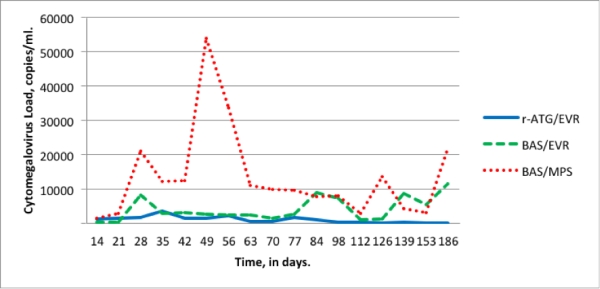Kinetics of Cytomegalovirus Load in Kidney Transplant Recipients Receiving Everolimus or Mycophenolate Sodium and No Pharmacological Prophylaxis.
Hospital do Rim, São Paulo, Brazil.
Meeting: 2016 American Transplant Congress
Abstract number: C274
Keywords: Cytomeglovirus, Immunosuppression, Kidney transplantation, Sirolimus (SLR)
Session Information
Session Name: Poster Session C: Viruses and SOT
Session Type: Poster Session
Date: Monday, June 13, 2016
Session Time: 6:00pm-7:00pm
 Presentation Time: 6:00pm-7:00pm
Presentation Time: 6:00pm-7:00pm
Location: Halls C&D
The purpose of this analysis is to investigate the kinetics of cytomegalovirus (CMV) viral load in kidney transplant recipients receiving tacrolimus (TAC) plus everolimus (EVR) or mycophenolate sodium (MPS) and no CMV pharmacological prophylaxis.
Method: This is a pre-planned comparative analysis of data from a prospective, single-center trial, in which 288 kidney transplanted patients were randomized to receive a single 3mg/kg dose of antithymocyte globulin, TAC, EVR and prednisone (r-ATG/EVR, n=85); basiliximab, TAC, EVR and prednisone (BAS/EVR, n=102); or basiliximab, TAC, MPS and prednisone (BAS/MPS, n=101). All patients were monitored with weekly pp65 antigenemia (AgCMV). CMV infection (>10 positive cells/200.000 in asymptomatic patients) or disease (any positive cell number in symptomatic patients) were treated with intravenous gancyclovir. In a blinded fashion, samples were collected for quantitative nucleic acid testing (QNAT, in-house method). The magnitude of viral load was analyzed using the area under curve (AUC) method (viral load as a function of time after transplantation from day 7 to 180).
Results: The incidence of first CMV infection/disease was lower in patients receiving EVR (4.7 vs. 10.8 vs. 37.6%, p<0.001), respectively. There was a correlation between AgCMV and QNAT (r2= 0,44, p<0,05) using 5184 paired samples. The proportion of patients with a positive QNAT (>50 copies/ml) was lower in BAS/EVR group (75 vs. 45 vs. 75%, p=0.01), respectively. Although patients in r-ATG/ EVR group had the same proportion of patients with a positive QNAT, the magnitude the AUC was significantly lower (1097.9 vs. 4252.2 vs. 13572.8 copies/ml/day, p<0,001) (figure 1). 
Conclusion: In kidney transplant recipients receiving no CMV pharmacological prophylaxis the use of EVR is associated with lower incidence of CMV infection/disease and lower viral load compared to those receiving MPS. These effects may mitigate the indirect effects of the virus on long-term patient and graft survival.
CITATION INFORMATION: Basso G, Felipe C, Ferreira A, Cristelli M, Oliveira N, Sandes-Freitas T, Mansur J, Viana L, Aguiar W, Campos E, Gerbasi-DeLima M, Tedesco-Silva H, Medina-Pestana J. Kinetics of Cytomegalovirus Load in Kidney Transplant Recipients Receiving Everolimus or Mycophenolate Sodium and No Pharmacological Prophylaxis. Am J Transplant. 2016;16 (suppl 3).
To cite this abstract in AMA style:
Basso G, Felipe C, Ferreira A, Cristelli M, Oliveira N, Sandes-Freitas T, Mansur J, Viana L, Aguiar W, Campos E, Gerbasi-DeLima M, Tedesco-Silva H, Medina-Pestana J. Kinetics of Cytomegalovirus Load in Kidney Transplant Recipients Receiving Everolimus or Mycophenolate Sodium and No Pharmacological Prophylaxis. [abstract]. Am J Transplant. 2016; 16 (suppl 3). https://atcmeetingabstracts.com/abstract/kinetics-of-cytomegalovirus-load-in-kidney-transplant-recipients-receiving-everolimus-or-mycophenolate-sodium-and-no-pharmacological-prophylaxis/. Accessed January 6, 2026.« Back to 2016 American Transplant Congress
